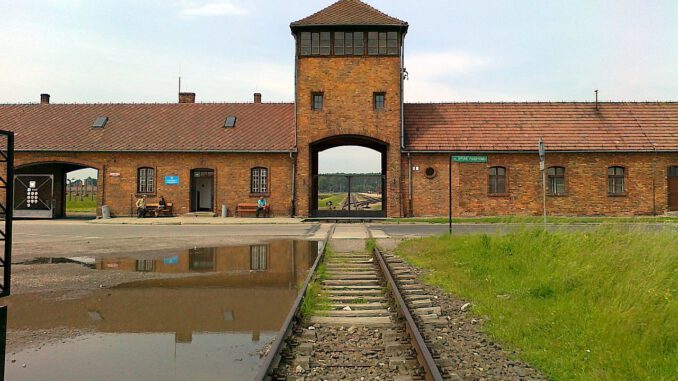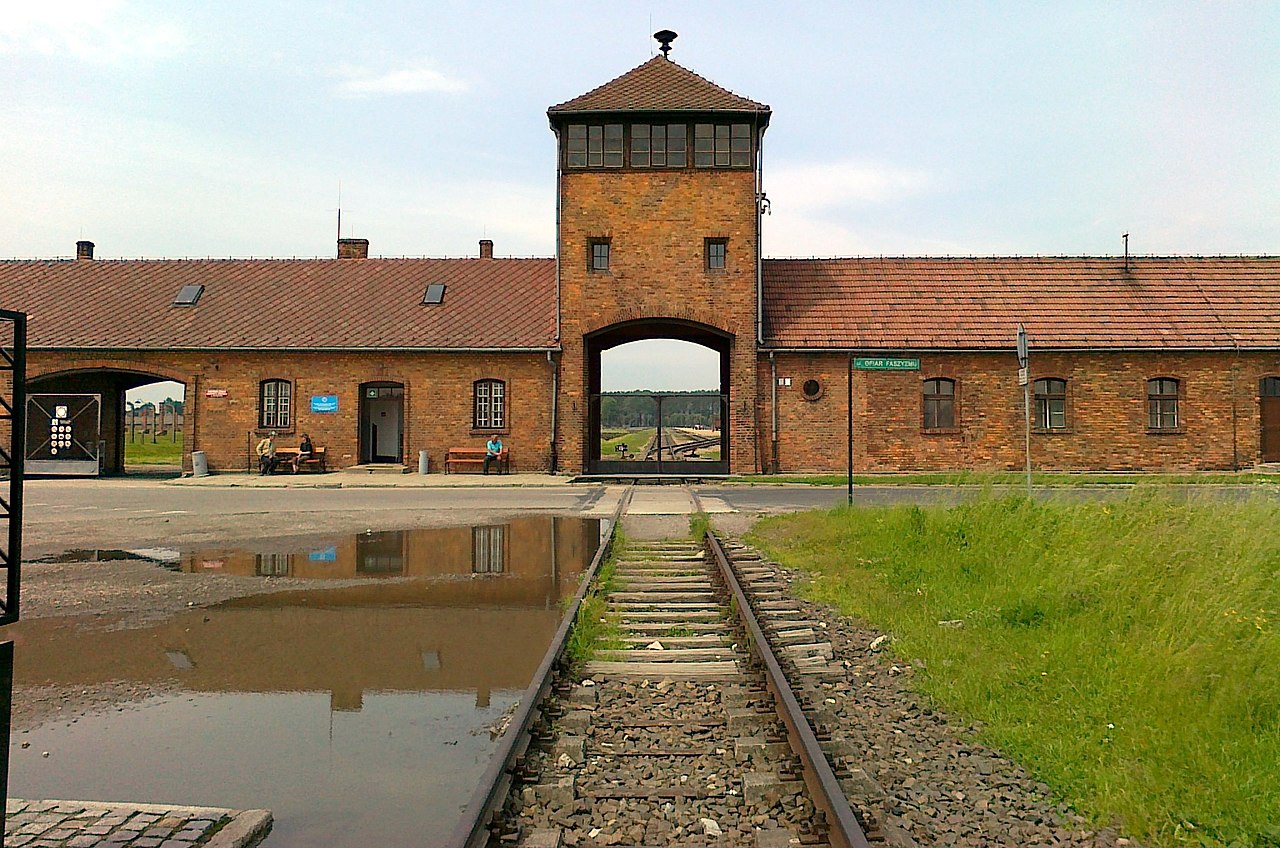
JANUARY 27, 2024 BY SHELLY PALMER
Original article: https://shellypalmer.com/2024/01/technology-of-death/?mc_cid=8680e83eb2&mc_eid=29c57030f9
January 27 is the International Day of Commemoration in Memory of the Victims of the Holocaust. It marks the anniversary of the liberation of Auschwitz-Birkenau, the largest Nazi extermination camp. In the Hebrew calendar, 27 Nisan is Yom HaShoah (Holocaust Remembrance Day). It marks the beginning of the Warsaw Ghetto Uprising of 1943. Every year on both days, I offer this account of my trip to Auschwitz-Birkenau to make sure we never forget!
The walk along the railroad tracks to the main building in Birkenau was terrifying. I was about to enter the largest of the 40 Nazi extermination camps and sub-camps that made up the Auschwitz complex and its reputation preceded it.

Gate to Auschwitz I with its Arbeit macht frei sign („work sets you free“) © wikipedia
At first glance, it doesn’t look like much. Twenty or thirty barracks, a few bricks, some wood, an electric fence and a few watchtowers. Then, walking down to the „selection platform“, a strategically located area in the middle of the camp where the camp doctor decided who went straight to the gas chambers and who was admitted to the camp, it hit you: every other chimney was a barrack, 400 people in each. When it was fully operational, 175,000 to 250,000 people were imprisoned here, each with a life expectancy that could be measured in minutes to months.

Wooden Barracks at Birkenau @ Shelly Palmer
I was not prepared for the size of Birkenau or the scale of industry required to kill so many people in a demoralizing, hopeless way. I was not prepared for the organizational skills required to profit from the looting, nor was I prepared for the economics of selling human hair and smelting gold and silver from dental fillings. This death factory used every available technology to maximize results, and the efficiency sickened me.

Ruins of the Wooden Barracks at Birkenau @ Shelly Palmer
Tattoo vs. Picture

Photographic Prisoner Registration @ Shelly Palmer
According to our guide, every prisoner was photographed in the beginning. In Auschwitz I there is now a room filled with uniforms, pictures and lists of prisoners. But the SS officers had a problem; when prisoners died of starvation or exposure (even within a few weeks), it was difficult to identify the bodies in the pictures. The solution was to tattoo the prisoners with identification numbers. This made counting bodies much more efficient.
Selection

The selection platform looking toward the women’s camp © Shelly Palmer
In the center of the camp, the selection platform (pictured above) was a place that should never have existed anywhere in the universe. Here, one man (the camp doctor) stood and decided within seconds who would be admitted to the camp and who would be immediately „disinfected“ – the euphemism for the gas chamber. About 70 percent of the deportees were killed within a day of their arrival in Birkenau. If you were old, infirm, ill, pregnant or under 14 years old, you were killed on the day of your arrival. Those who were fit and able to work were taken into the camp. Having experienced how the prisoners lived, I’m not sure who had the better end of the deal – those who were killed outright or those who were worked and slowly starved to death.

The selection platform in use during the 1940s © Shelly Palmer
Living conditions

Inside a reproduction of a Wooden Barracks at Birkenau © Shelly Palmer
The wooden barracks were the first thing I saw here, and the description set the tone for the rest of the day. Up to 400 people had to live here. The floor was made of dirt (not concrete like today). The walls didn’t reach the roof, so there was almost no protection from the elements. The heat would be uninhabitable in summer and the cold in winter would be almost impossible to survive. There were two stoves for heating in each barrack, but they were never used. It was too complicated to organize the distribution of wood or other suitable fuels.

Inside the latrine barracks at Birkenau (notice the walls don’t touch the roof) @ Shelly Palmer
The prisoners were not allowed to leave the barracks once they were inside and there were no sanitary facilities. If you had to relieve yourself, you did it in your clothes or in your bed or wherever you were. There were two trips to the latrine every day. Think of the smell, the sickness, the discomfort, the lack of dignity – the level of dehumanization is almost unimaginable, but the evidence is there. It happened exactly where I stood 72 years ago – within the length of a human life.
Gas chambers

The ruins of one of Birkenau’s Gas Chambers © Shelly Palmer
The Nazis destroyed the gas chambers and crematoria at Birkenau about 10 days before the camp was liberated. The ruins are still heartbreaking. Each gas chamber could kill 2,000 people in about 25 minutes. This task was accomplished with a remarkable degree of stagecraft and technology. People were assured that they would be taken for disinfection before being admitted to the camp. They were told to memorize the number of the hook on which they hung their clothes. They were then herded naked into the chamber. SS officers used cans of Zyklon B mixed with diatomaceous earth crystals. When the cans were opened, the hydrogen cyanide-saturated crystals released the poisonous gas. We were told that the lucky ones were the people standing near the openings into which the canisters fell. They died within seconds. Those at the other end of the chamber took up to 25 minutes to die.
Crematorium

The Ovens in Crematorium #1 at Auschwitz 1 © Shelly Palmer
Then the bodies had to be taken to the crematorium, where the Nazis could burn around 1,500 bodies per hour. Birkenau was built with the knowledge the Nazis had gleaned from Auschwitz Crematorium #1 (pictured above), which had a capacity of only 700 people per hour and far fewer ovens. Even in Birkenau, the crematoria were overloaded and the Nazis had to resort to burning bodies in open pits. Even today, small pieces of bone occasionally turn up in the fields around the camp when it rains. It is difficult to find adequate words to describe this.
What I have learned

Ben Golub (13) leaving Birkenau © Shelly Palmer
What made men do this? It’s worse than hate, worse than fear, worse than greed or jealousy or anything else I’ve ever felt. I don’t know how anyone could justify killing anyone, so I can’t even imagine what inspires a nation to dream up, fabricate, operationalize and use a killing factory. And Birkenau was just one of many.
The technological efficiency on display here makes it the most organized crime in history. It was sociologically skillful; the Nazis began to dismantle the Jews in a methodical way, first by disrupting their businesses, then by disrupting their lives, then by robbing them of their property, their dignity, and finally their lives. But it was also technologically skillful in a way that hit me harder here in Birkenau than even in Auschwitz I. For some, in an extermination camp where even hope was dead, it was just another day at the office. The SS officers set about killing as many people as possible as quickly and efficiently as possible.
One day I will take my children and grandchildren to see this place. And when we leave Birkenau, we will turn our backs on the Nazis and everything they stood for. We will still be here – a living memorial to countless, nameless millions. I will teach them that this kind of evil can never be defeated. It simply hides. And in that moment, they will know in a primal, instinctive way why we must never forget!
Author’s note: I wrote this article after traveling to Auschwitz-Birkenau, the Warsaw Ghetto and other places associated with the Holocaust. It was originally published on March 23, 2014.
ABOUT SHELLY PALMER
Shelly Palmer is Professor of Advanced Media in Residence at Syracuse University’s S.I. Newhouse School of Public Communications and CEO of The Palmer Group, a consulting firm serving Fortune 500 companies in technology, media and marketing. He was named a „Top Voice in Technology“ by LinkedIn, reports on technology and business for Good Day New York, is a regular commentator on CNN and writes a popular daily business blog. He is a best-selling author and creator of the popular, free online course Generative AI for Execs. Follow @shellypalmer or visit shellypalmer.com.
Original post: https://shellypalmer.com/2024/01/technology-of-death/?mc_cid=8680e83eb2&mc_eid=29c57030f9
Postscript:
I picked up this post because it speaks to my heart. Because it is not so long ago that these atrocities were committed by humans against humans that we can forget them. Because in Germany, Europe and the USA we are experiencing a strengthening of nationalism, fascism, anti-Semitism and discrimination. Because it is intolerable that we in Germany are adorned with over 1 million demonstrators against the right in a country with a population of over 80 million people. Because people look the other way when Nazi symbols are sprayed on memorial plaques and pictures for the victims of fascism or other crimes are committed.
I thank all the people who see it as their duty to stand up for a humanistic society every day and not to pass their own problems onto others. I thank the people who have the courage to stand out from the gray and silent masses and not just when the cameras show up. I admire people who say no out loud to other people, who start a sentence with „I’m not right-wing, but …“
Thanks to Shelly Palmer for this important contribution.
More posts on the topic:
https://www.leuchtturmleuchten.de/politik/gesellschaft/stilles-gedenken-75-jahre-befreiung-des-kz-auschwitz-2/
https://www.leuchtturmleuchten.de/politik/9-november-1938-es-wird-nie-vergessen/
https://www.leuchtturmleuchten.de/politik/gesellschaft/zwei-daten-ein-tag-eine-geschichte-niewieder/